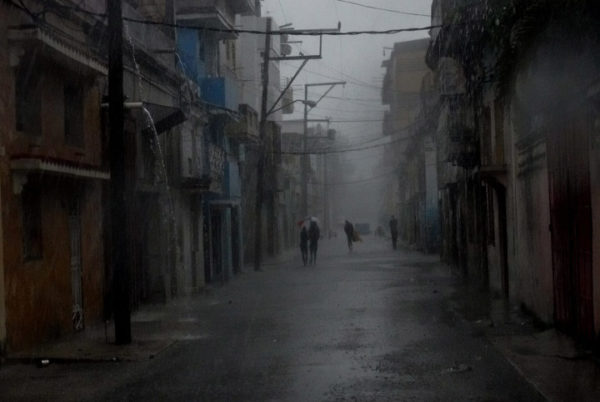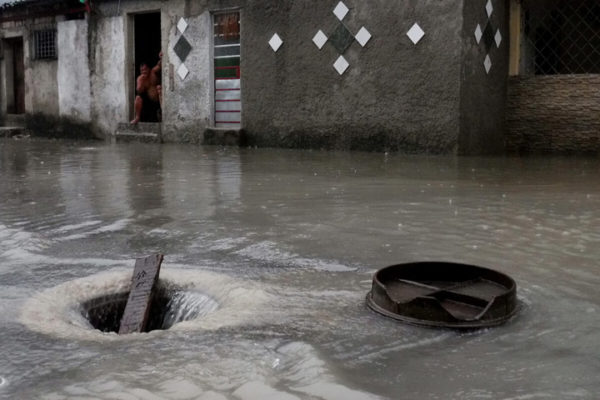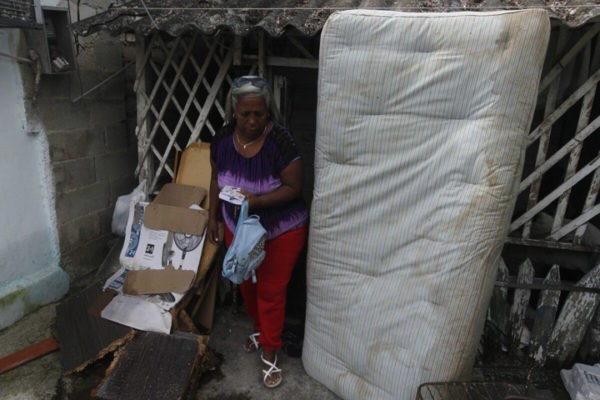First Heavy Rains of the Year Expose Cuba’s Weak Spots
With hurricane season just beginning

In addition to damaged crops and cuts in telecommunications and electricity supplies, the rain left four Cubans dead and over a thousand homes partially or totally destroyed.
By Luis Brizuela (IPS Cuba)
HAVANA TIMES – Damp-stained walls, broken pieces of furniture and electrical appliances still sitting on the highest shelves confirm the damage caused by heavy rains in early June to Guillermina Alberja’s home, in the Cuban capital.
“The important thing is action was immediately taken, lives weren’t lost, because it swelled really quickly. It’s the worst flood I’ve seen in the 20 years I’ve been living in El Fanguito,” Alberja said before asking a neighbor to help her put one of her mattresses out in the sun.
El Fanguito was one of the communities hardest hit in Havana by torrential rains between June 2-6, flooding areas of the western and central provinces on this Caribbean island.
“Municipal and provincial authorities’ concern needs to be recognized, as they came to check on evacuation procedures, giving priority attention to families affected, selling food and then organizing recovery efforts,” the coordinator of a neighborhood organization explained to IPS.
With houses sitting along the Almendares river and near the estuary, some 600 of the over 1200 residents in El Fanguito ended up with damages by floodwater, mud and waste. Two centers to give shelter to these families were set up.
“When the river swells, my backyard floods, but this time it came into the house – made of wood and with a rickety roof – and it soaked all the clothes, beds and devices,” another neighbor, Aleida Perez, told IPS, her voice faltering as a result of her asthma “because of the tremendous humidity inside the house.”
Studies of hazards, weak spots and risks support the relocation of at least 44 homes located within 20 m of the river, which include the homes of Alberjas, Perez and their families, although the resettlement of another 100 households hit by the flood needs to be reviewed.
With a housing inventory of 598 houses, 72% of which are in a regular or poor state, El Fanguito is one of Havana’s 67 neighborhoods that the rains proved were especially vulnerable.
After the protests in July 2021, these settlements and others across the country have received an injection of state resources to solve basic needs that hadn’t been met in terms of construction and renovations of homes, roads and drinking water supplies, as well as the sewage system, and other things. But they were far from what’s needed.

Weak spots
Preliminary reports indicate that 55% of the average monthly rainfall fell in just a few days, although the mean monthly accumulated rainfall was over 100% of the average for June, the second month of the wet season (May – October) in Matanzas province and especially the Isle of Youth – the second largest island in this archipelago.
This weather phenomenon activated Cuba’s Civil Defense system, which is organized on both a national and local level, to deal with exceptional situations such as hurricanes, tornados, floods or chemical leaks to protect the population and economy.
This system includes prevention, preparation, surveillance, early warning and danger forecasts, variables and risk assessment, as well as warning and guiding the general population.
In addition to damaged crops and cuts in telecommunications and electricity supplies, the rain left four Cubans dead and over 1200 homes partially or totally destroyed, according to official reports.
There were a hundred partial collapses in Havana alone, where 2.2 million residents live in its 15 municipalities, two of which totally collapsed, and many areas became flooded.
“When they announce rain, I fear for my life. In addition to leaking through the walls, I’m afraid the roof will fall in on top of me,” retiree Ofelia Nodarse confessed to IPS. She lives in a building that is almost 100 years old in the Central Havana municipality. And most such buildings have had little or no maintenance in the last 60+ years.
“Fixing up a home is extremely expensive, and buying a new place is completely out of the question. You can find all kinds of material on the black market. A bag of cement (42 kg) costs almost a quarter of my monthly wages,” professor Enrique Bermudez, another resident of this municipality, told IPS.
Bermudez earns just over 200 USD at the official exchange rate, but this sum drops to just 45 USD if you bear in mind exchange rates that dominate the black market of basic essentials and products in shortage at state-led stores.

According to statistics, 37% of Cuba’s over 3.9 million properties are in a regular or poor technical state. Add to this the deficit of over 863,000 homes in a country with 11.2 million inhabitants.
Cuba’s Housing Policy came into effect in 2019, a government plan that aims to eliminate this deficit in a decade and is being implemented by the Ministry of Construction. However, its way behind schedule already.
In the first four months of this year, 7,914 homes were completed, 20.8% of the almost 38,000 that were expected to be completed in Cuba in 2022, according to official plans.
At a rate of 38,000 houses per year, it would take Cuba 22 years to offset this deficit, without taking into account future damage caused by hurricanes or other natural disasters. Few believe conditions will exist to actually meet the plan.
The chronic economic crisis that has been dragging the island down under for three decades and the decapitalization of its main industries affects low production of cement, rebar, sand, gravel and other materials.
The US embargo is another factor that works against the building material industry, as it limits access to international credit to modernize the sector, the Government explains.
Managing risk and investment
However, the country also needs to invest in new works on the sewage system, traps and drainpipes, as “many are blocked due to unsuitable road repairs, a lack of systematic cleaning of drains, or because of garbage piling up on street corners or people throwing it out on the street,” engineer Alexis Núñez told IPS.

Living in the capital’s Playa municipality, in an area that “always floods when it rains heavily.” Nuñez pointed out that part of Havana’s drainage system “is collapsing because it’s over 100 years old.”
Studies recognize that proper risk management and hazard reduction at a local level can reduce the damaging consequences of natural disasters, which needs to go hand-in-hand with greater education of the masses to increase their risk perception when extreme weather phenomena hit.
“If hotels need to be built because tourism is a focal point for the economy, then it’s just as important – or even more so – that every Cuban has a dignified home, where they aren’t afraid of losing their electrical appliances when it rains or live with the anxiety that their building might collapse,” the young architect Yanelis Peguero, who also lives in Playa, told IPS.
In 2021 alone, business services, building activity and rentals, which includes hotels and other tourism investments, represented 35.2% of all government investment in Cuba, compared to the 1.7% for the home building sector, statistics from Cuba’s Office of Statistics and Information (ONEI) show.
Other experts urge for professions, such as architecture – which is an activity that experts believe will contribute to reinforcing urban laws and improving the quality, security, purpose, and aesthetic of new construction projects -, to finally be authorized as they remain banned up until now.
Forecasts estimate that the 2022 huricane season, from June 1st – November 30th in the northern Atlantic, Gulf of Mexico and the Caribbean Sea, could be very active with 17 named tropical storms possibly forming.
According to the Institute of Meteorology, based in Havana, there is an 85% chance that a tropical storm hits Cuba during these months.
The “Repercussions in Latin America and the Caribbean of the war in Ukraine: how should the region face this new crisis?”, published on June 6th by the Economic Commission for Latin America and the Caribbean (CEPAL), shows that food represented 29.7% of total imports in Cuba in 2019, the third greatest proportion out of the 28 countries in the region.
Official statistics indicate that the island imports approximately 70% of the food it consumes.
Such figures suppose a great vulnerability with prices going up and supplies being unstable, a situation that could get worse if a high-intensity hurricane hits the island, whose financial problems makes buying food abroad even harder.





